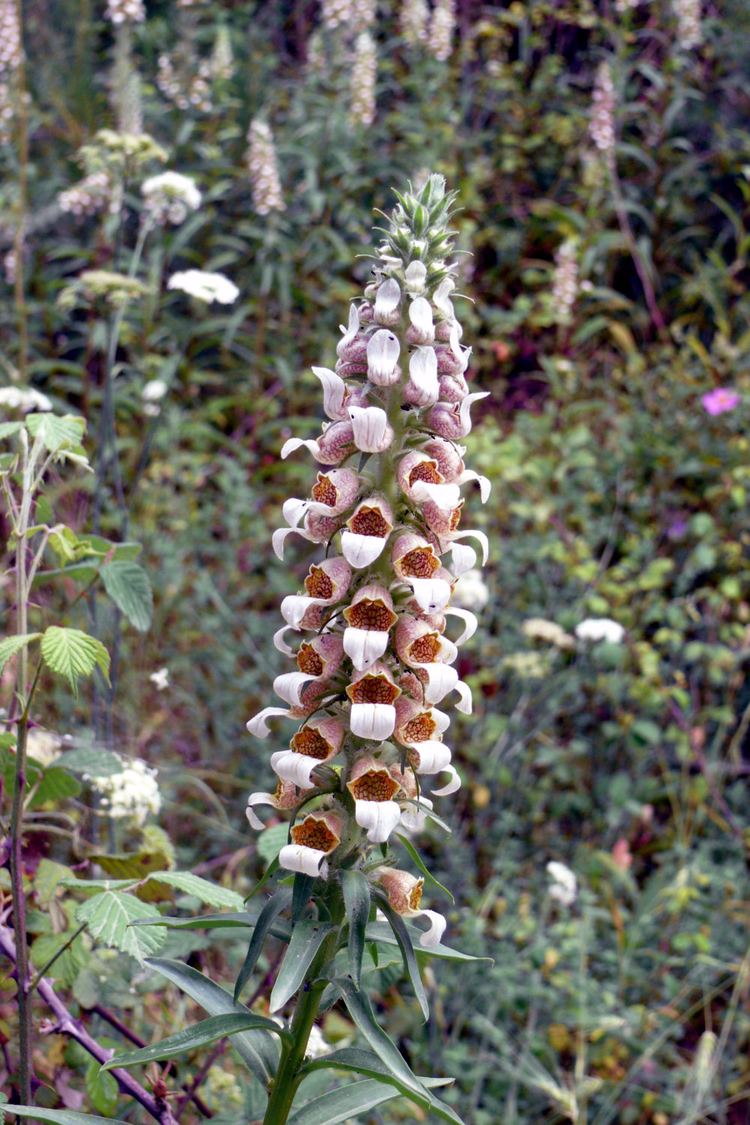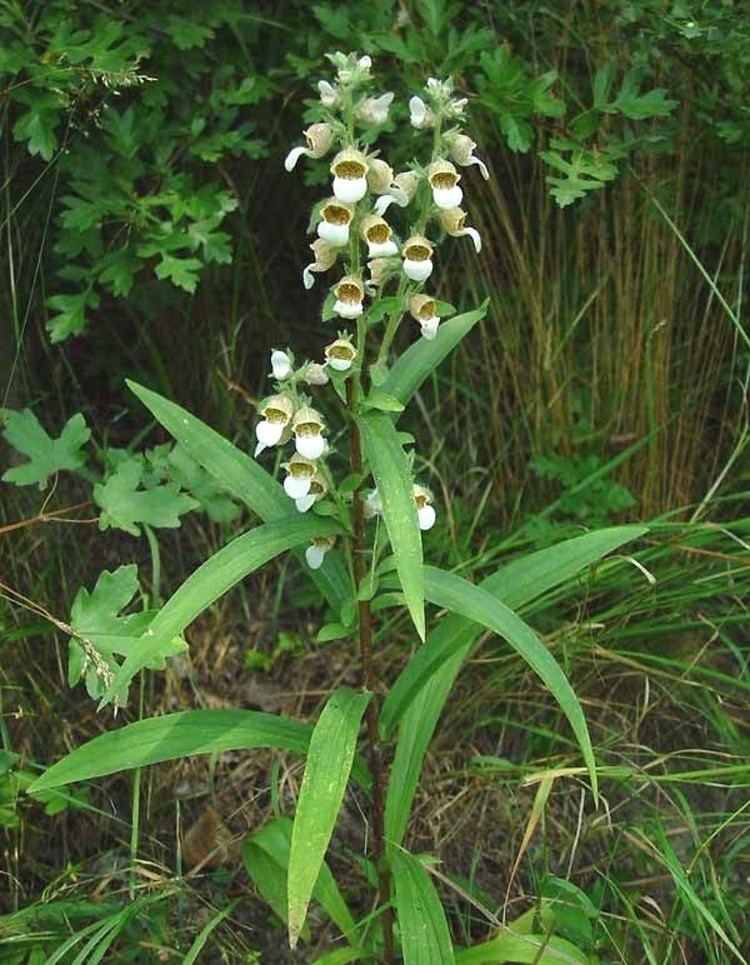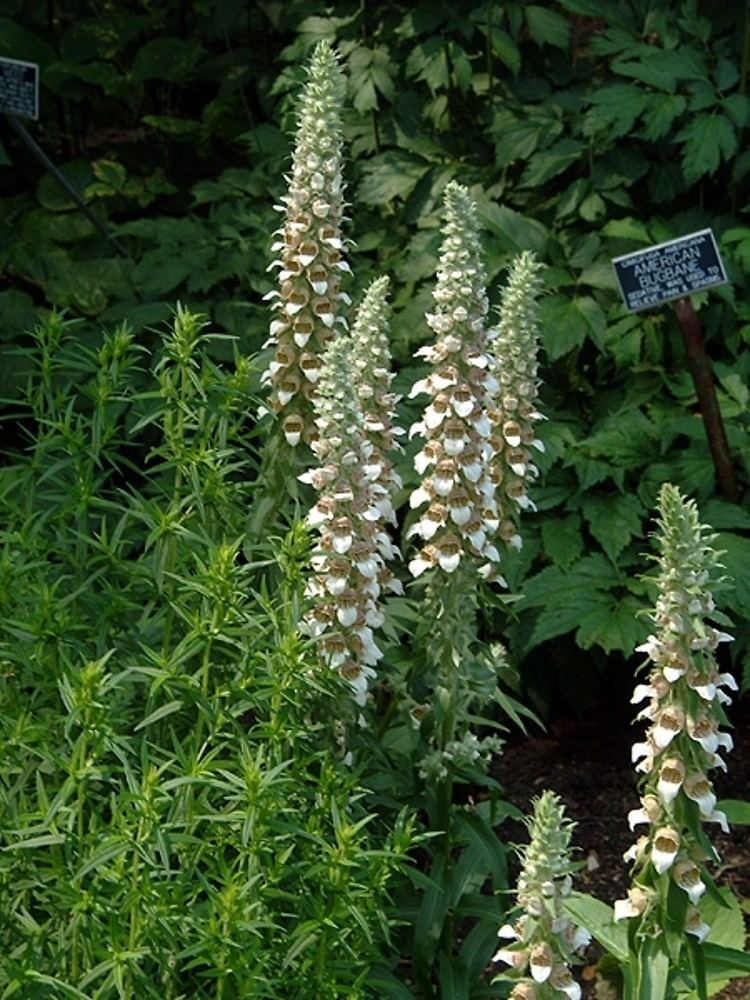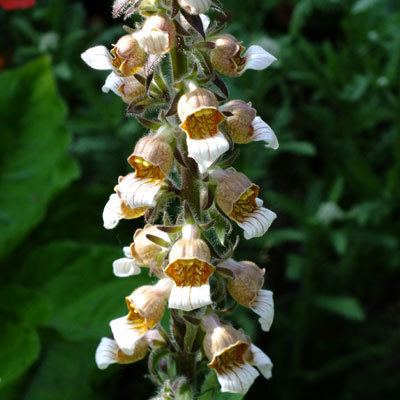Rank Species | Genus Digitalis Higher classification Foxgloves | |
 | ||
Similar Foxgloves, Digitalis purpurea, Digitalis grandiflora, Digitalis lutea, Digitalis ferruginea | ||
Digitalis lanata
Digitalis lanata (often called woolly foxglove or Grecian foxglove) is a species of foxglove. It gets its name due to the texture of the leaves. Digitalis lanata, like some other foxglove species, is highly toxic in all parts of the plant. Even the ingestion of small amounts by humans can be fatal, particularly children . Symptoms of digitalis poisoning include nausea, vomiting, severe headache, dilated pupils, problems with eyesight, and convulsions at the worst level of toxicity. The plant is also harmful to other animals. In some cases it is considered invasive or a noxious weed. Minnesota is one of the few places that consider it invasive as noted by the Western Weed Society. It is in leaf all year, in flower in June and July, and the seeds ripen in early-mid September. The flowers are hermaphroditic (having both male and female organs). Bees pollinate the flowers.
Contents

Description

The plant commonly grows from 0.3 to 0.6 meters in height, or about 13 to 26 inches. The plant prefers part shade and humus rich soil. The plant also prefers sandy, loamy, and clay soils. It can grow under dry or moist conditions. Seeds develop in pods that have small hooks, enabling the pods to be transported by animal fur or clothing. The elongated leaves are mid–green, wooly, veined, and covered with white hairs on the underside. They also have a very bitter taste. There is a tidy rosette before the spike goes up, and it is neatly arranged around the purple-tinged stems. The flowers are tubular and bell shaped with a creamy-white color and purplish-brown netting as well as a long broad lip. The flowers usually bloom in the second year. Both flowers and stems are also woolly or hairy.
Distribution

It is found mostly in Eastern Europe. One of the biggest populations can be found near Bácsalmás in Hungary. Even though it is native to Europe, the plant can now be found throughout the world, growing in woodland areas, on roadsides, and in mountainous regions. In North America, it can be found mostly in the Northeast and Southwest regions. It is cultivated mainly in New York, Washington, Utah, and Colorado.
Taxonomy
The Plantaginaceae family, also known as the plantain family, is a family of flowering plants included in the order Lamiales. The Plantaginaceae family was not originally placed in the order Lamiales, but in the order Plantaginales. However, in recent years phylogenetic studies conducted by the Angiosperm Phylogeny Group have indicated that it should be included in the order Lamiales. The original family name was Veronicaceae until 1789 when the family name became Plantaginaceae. This is the conserved name under the International Code of Botanical Nomenclature (ICBN). ICBN does not consider family names before 1789 for conservation, as a result Veronicaceae is not eligible for conservation. Digitalis lanata has several other common names such as "Grecian foxglove" and "woolly foxglove". The name Digitalis comes from the Latin word digitus, which means finger. Digitalis was first recorded in the English language in 1664 in a published work. This genus name was chosen because the German name for foxglove is Fingerhut, which means " finger hat" (thimble). The glove portion of the name originates from the similarity of the foxglove blossoms to the fingers of a glove.
Physiology

The species is adapted to sunny and warm sites on dry, mostly on sandy and stony loamy soil. During the first vegetation period, only the leaf rosette is developed, flowering follows during the second vegetation period. Therefore, especially during the first year, there is a high resistance against water stress (drought stress). Indeed, the leaves remain turgescent even under very low leaf water potential, due to osmotic adaptation by synthesis of non-ionic substances in the leaves. The drought induced diminishing of photosynthesis is reversible after a few hours following watering of the plants. Drought stress also reduces the quantum yield of photosystem 2. More than 70 bitter glycosides with cardiac activity, with five different aglyconees digitoxigenin, gitoxigenin, digoxigenin, diginatigenin and gitaloxigenin in the leaves act as a protection against herbivores. Yield and concentration of these cardiac glycosides are enhanced by greenhouse cultivation through enhanced temperature and enhanced carbon dioxide concentration.
Medical uses

Digitalis lanata contains a powerful cardiac glycoside that may be used by patients with heart conditions. Digoxin (digitalin) is a drug that is extracted from Digitalis lanata. It is used to treat some heart conditions such as atrial fibrillation. It slows atrioventricular conduction so that the heartbeat slows down and slightly increases contraction power (positive inotropic effect). Because of the improved circulation in congestive heart failure caused by fast atrial fibrillation, the kidneys can function better, which stimulates the flow of urine, which lowers the volume of the blood and lessens the load on the heart. This is the effect that was first described when the plant was discovered as a medicine (Withering 1785). Digitalin was not discovered until the mid-19th century by two French scientists Homolle Ouevenne and Theodore Ouevenne. It was not until 1875 that Oscar Schmiedberg identified digoxin in the plant. It was first isolated in the 1930s in Britain by Sydney Smith. At that time it was used to treat ulcers in the lower abdomen, boils, headaches, abscesses, and paralysis, and externally healing wounds. Today it is still extracted from the plant because synthetis is quite expensive and difficult. However, it is becoming less frequently used due to the narrow therapeutic margin and high potential for severe side effects. Digoxin is being replaced by newer drugs including beta blockers, angiotensin-converting enzyme inhibitors, and the calcium channel blocking agents. As new pharmacotherapeutic agents arise, the use of digitalis preparations is expected to continue to decline. There are also other commercial uses for Digitalis lanata other than heart conditions. For example, in South America the powdered leaves are used to relieve asthma, as sedatives, and as diuretics. In India it is included in an ointment that contains digitalis glycosides used to treat wounds and burns.

